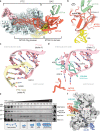Stepwise maturation of the peptidyl transferase region of human mitoribosomes
- PMID: 34135320
- PMCID: PMC8208988
- DOI: 10.1038/s41467-021-23811-8
Stepwise maturation of the peptidyl transferase region of human mitoribosomes
Abstract
Mitochondrial ribosomes are specialized for the synthesis of membrane proteins responsible for oxidative phosphorylation. Mammalian mitoribosomes have diverged considerably from the ancestral bacterial ribosomes and feature dramatically reduced ribosomal RNAs. The structural basis of the mammalian mitochondrial ribosome assembly is currently not well understood. Here we present eight distinct assembly intermediates of the human large mitoribosomal subunit involving seven assembly factors. We discover that the NSUN4-MTERF4 dimer plays a critical role in the process by stabilizing the 16S rRNA in a conformation that exposes the functionally important regions of rRNA for modification by the MRM2 methyltransferase and quality control interactions with the conserved mitochondrial GTPase MTG2 that contacts the sarcin-ricin loop and the immature active site. The successive action of these factors leads to the formation of the peptidyl transferase active site of the mitoribosome and the folding of the surrounding rRNA regions responsible for interactions with tRNAs and the small ribosomal subunit.
Conflict of interest statement
The authors declare no competing interests.
Figures




Similar articles
-
Structural basis for late maturation steps of the human mitoribosomal large subunit.Nat Commun. 2021 Jun 16;12(1):3673. doi: 10.1038/s41467-021-23617-8. Nat Commun. 2021. PMID: 34135318 Free PMC article.
-
Structural basis of GTPase-mediated mitochondrial ribosome biogenesis and recycling.Nat Commun. 2021 Jun 16;12(1):3672. doi: 10.1038/s41467-021-23702-y. Nat Commun. 2021. PMID: 34135319 Free PMC article.
-
Structural Insights into the Mechanism of Mitoribosomal Large Subunit Biogenesis.Mol Cell. 2020 Aug 20;79(4):629-644.e4. doi: 10.1016/j.molcel.2020.06.030. Epub 2020 Jul 16. Mol Cell. 2020. PMID: 32679035
-
Mechanisms and players of mitoribosomal biogenesis revealed in trypanosomatids.Trends Parasitol. 2022 Dec;38(12):1053-1067. doi: 10.1016/j.pt.2022.08.010. Epub 2022 Sep 6. Trends Parasitol. 2022. PMID: 36075844 Review.
-
Mitochondrial ribosome assembly in health and disease.Cell Cycle. 2015;14(14):2226-50. doi: 10.1080/15384101.2015.1053672. Epub 2015 Jun 1. Cell Cycle. 2015. PMID: 26030272 Free PMC article. Review.
Cited by
-
Visualizing formation of the active site in the mitochondrial ribosome.Elife. 2021 Oct 5;10:e68806. doi: 10.7554/eLife.68806. Elife. 2021. PMID: 34609277 Free PMC article.
-
Coupling of ribosome biogenesis and translation initiation in human mitochondria.Nat Commun. 2025 Apr 17;16(1):3641. doi: 10.1038/s41467-025-58827-x. Nat Commun. 2025. PMID: 40240327 Free PMC article.
-
The mitochondrial methylation potential gates mitoribosome assembly.Nat Commun. 2025 Jun 25;16(1):5388. doi: 10.1038/s41467-025-60977-x. Nat Commun. 2025. PMID: 40562754 Free PMC article.
-
Structural insights into the role of GTPBP10 in the RNA maturation of the mitoribosome.Nat Commun. 2023 Dec 2;14(1):7991. doi: 10.1038/s41467-023-43599-z. Nat Commun. 2023. PMID: 38042949 Free PMC article.
-
The zinc finger motif in the mitochondrial large ribosomal subunit protein bL36m is essential for optimal yeast mitoribosome assembly and function.Biochim Biophys Acta Mol Cell Res. 2024 Apr;1871(4):119707. doi: 10.1016/j.bbamcr.2024.119707. Epub 2024 Mar 16. Biochim Biophys Acta Mol Cell Res. 2024. PMID: 38493895 Free PMC article.
References
Publication types
MeSH terms
Substances
LinkOut - more resources
Full Text Sources

